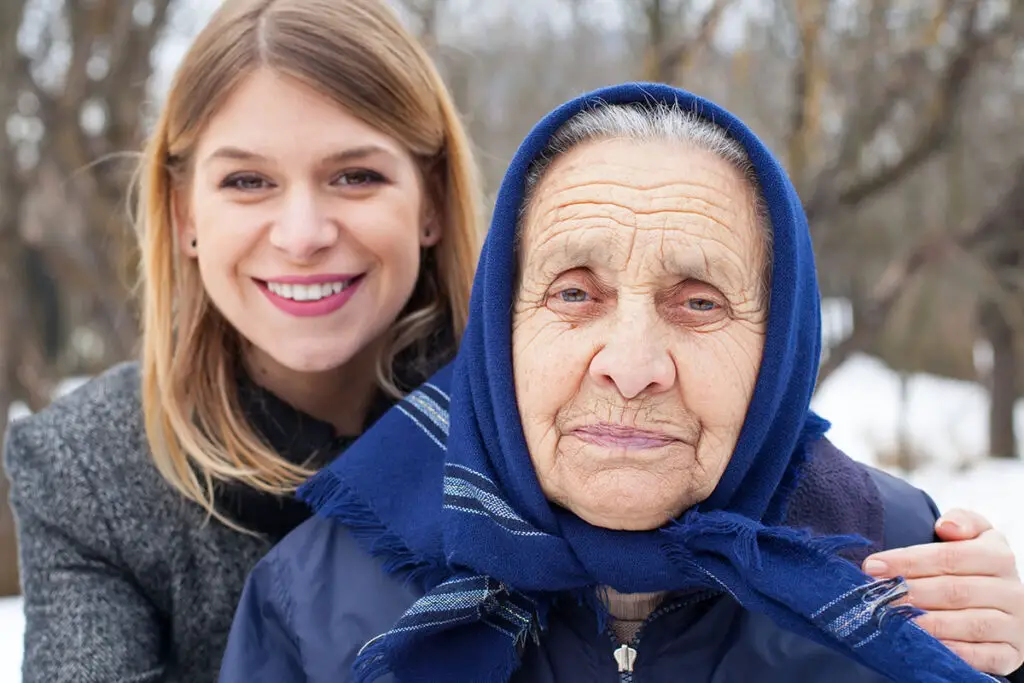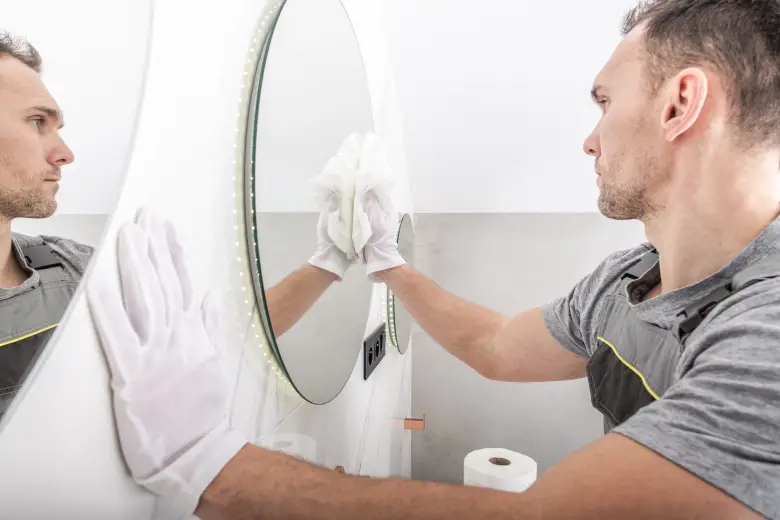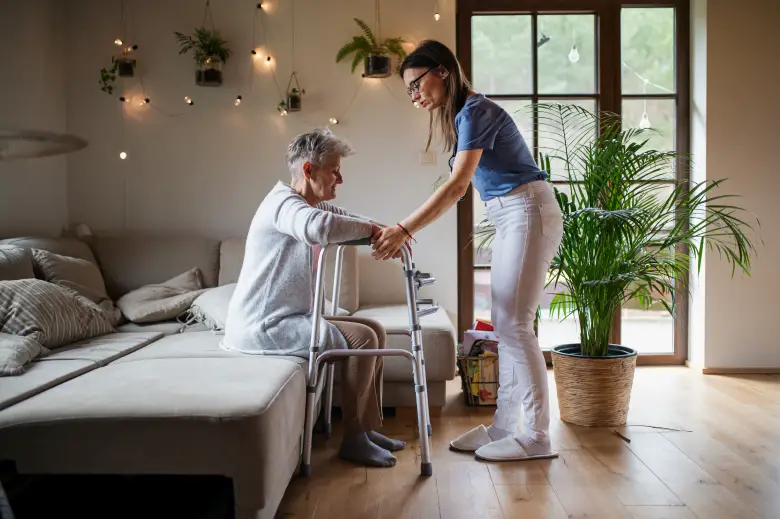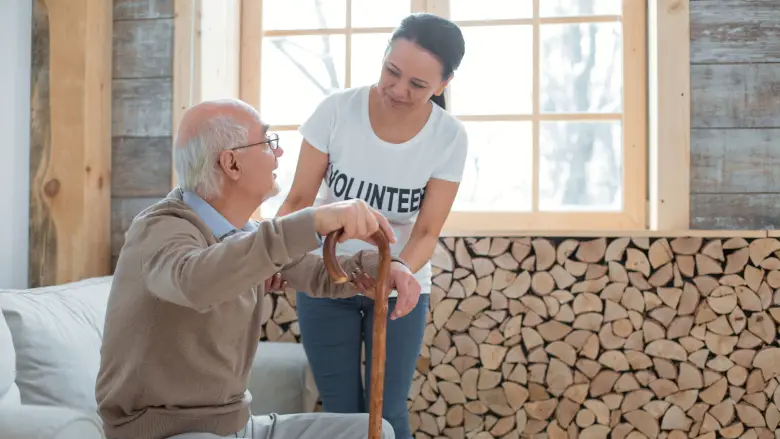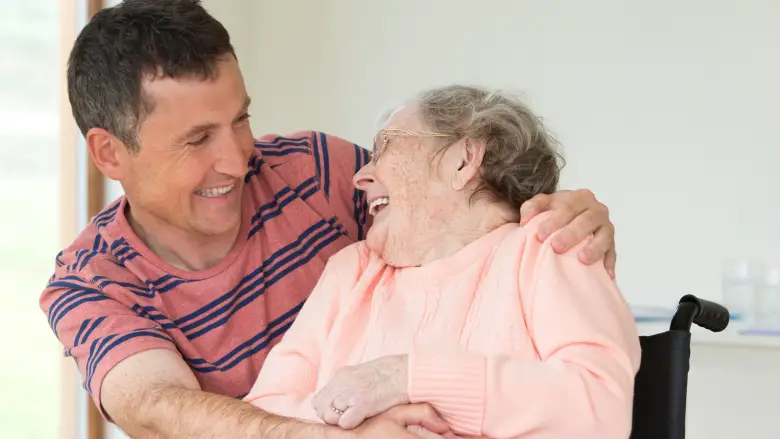In many English-speaking countries, the difference between the terms caretaker vs caregiver is easy to determine. Caretakers are employees who maintain places rather than provide personal services for individuals. So, for example, a caretaker would be hired to take care of church graveyards, estates, or vacation homes. On the other hand, a caregiver takes care of people, including those with serious illnesses, older individuals, and sometimes children.
For those living in North America, specifically Canada and the United States, the words caretaker and caregiver have come to refer to similar roles when it comes to assisting seniors in their homes. Because of this overlap, it may be hard to distinguish between the two positions. Generally, a caretaker is always a hired employee, but a caregiver could be a family member or friend.
Generally, a caretaker is someone who is paid to take care of a person whereas a caregiver can be both paid or unpaid. Read on to learn more of the nuances.
What is a Caretaker?
The traditional caretaker role is someone paid to look after a person, or in some cases, a property. When the term is used to refer to someone who takes care of a person, there is often very clear understanding by both the caretaker and employer about tasks the caretaker is responsible for, the payment amount, and the dates they will receive money for these services. This explicitness allows for distinct boundaries between the caretaker and the person receiving care, reducing the chance of either falling into a codependent relationship.
A senior might hire a personal caretaker through an agency, based on a recommendation, or from an ad. Adult children of someone in need of additional support might also hire a caretaker.
What Caretakers Do
The duties involved in a caretaking position vary according to individual needs, but the care is generally given in the senior’s home. The following are some of the tasks you could expect from a caretaker.
Transportation. As seniors age, it often becomes more difficult for them to drive. A caretaker can take on the responsibility of taking their charges to doctor’s appointments, religious services, social engagements, physical therapy, etc.
Activities of daily living. Caretaking responsibilities could include assisting with activities of daily living if the situation warrants it. Some basic activities of daily living (ADLs) consist of personal hygiene tasks, such as bathing, grooming, dressing, feeding, using the toilet, and toothbrushing.
A senior might need help with one or more of these tasks depending on their level of functional independence. It’s crucial to clarify ADL expectations with the caretaker and ensure they have all the equipment to complete the tasks safely. For instance, if the caretaker will be helping the senior to bathe or shower, the bathroom should be equipped with a shower chair or walk-in tub, grab bars, and non-slip mats.
Household tasks. A caretaker might also be in charge of specific household tasks. Again, these should be agreed upon when hiring so there are fewer misunderstandings later. The caretaker might complete the activities entirely or work in conjunction with their charge. Household chores could include laundry, washing dishes, vacuuming, sweeping, dusting, bringing in the mail, grocery shopping, meal preparation, pet care, general cleaning, and so on.
Medical assistance. A caretaker might provide medical assistance based on their qualifications. Caretakers that are not registered nurses should be trained in basic first-aid skills. With those skills, a caretaker could help with wound care, clean and dress the wound site, do blood sugar and blood pressure checks, and ensure their charge is taking their medication appropriately. Specialized medical procedures or complicated medical care should be left to qualified medical professionals for safety reasons. In this case, hiring a certified nursing assistant (CNA), nurse, or another specialist as a caretaker would be best.
Leisure activities. Numerous studies have shown the health benefits of remaining active while aging. For example, seniors with hobbies reduce their chances of developing heart disease, dementia, and certain cancers, whereas social isolation increases the risk of premature death, dementia, and stroke.
A caretaker could also participate with their charge in various leisure activities. For example, they may spend time talking or listening to stories about seniors’ lives or help them call their families regularly. Caretakers could help put puzzles together, do other handicrafts, work in the garden, or go for walks.
What is a Caregiver?
A caregiver is a person who physically, emotionally, or psychologically supports another person. Caregivers can be individuals who provide personal services to seniors as employees but can also include friends or family members who do not receive monetary compensation for their time. Anyone who is not paid to look after someone would be classified as a caregiver rather than a caretaker.
Approximately 53 million Americans were unpaid family caregivers in 2020. Furthermore, family caregivers report spending around 26 percent of their own income each year on caregiving activities.
Because of prior familiarity, caregivers often have closer relationships with their charges than caretakers. That is to say, because caregivers are friends or family members, they are in a position to provide more emotional support and companionship than a hired professional. However, this is not always the case.
Informal caregivers might not be trained to provide specific medical assistance. However, again this isn’t always true. Medical professionals may take on the caretaking tasks for friends or relatives as they age.
What Caregivers Do
Although a caregiver’s responsibilities may vary depending on the patient’s needs, caregivers generally provide many of the same services as caretakers. They may drive their charge to the grocery store, doctor’s office, or senior center. They could assist with daily living activities like feeding, bathing, or dressing.
They might help with household chores, including meal preparation, cleaning, or pet care. Depending on their abilities, caregivers could provide medical assistance such as checking blood pressure or organizing medications. Additionally, they can provide companionship or supervision as needed.
A caregiver may assume responsibility for other tasks such as making medical appointments, picking up prescriptions from the pharmacy, paying bills, and administering medications. Duties may change over time depending on the level of independence the person receiving caregiving services has.
6 Types of Caregivers
There are a variety of caregiver classifications that you should examine when deciding on care options, and different caregivers get paid different amounts depending on the type of work they do and where. Whichever type of caregiver you choose, be sure to be clear about their responsibilities.
Professional Caregiver
A professional caregiver is a paid employee with the experience and know-how to care for your loved one adequately. This type of caregiver may work independently for private clients or through an agency.
Family Caregiver
A family caregiver is a person who is related to the individual receiving caregiving services. Often this type of caregiver is unpaid. However, a family member can be reimbursed for expenses incurred as a family caregiver under certain conditions. For example, the National Family Caregiver Support Program (NFCSP) has a few resources you can look at to see if you qualify to become a paid family caregiver. See our article on family caregiver pay to learn more.
Informal Caregiver
Informal caregivers provide caregiving services without being paid, although similar to family caregivers, there may be situations when they qualify for reimbursement. Informal caregivers are often friends or acquaintances of the seniors who do what they can to support their loved one’s healthy independence. Informal caregivers might share the responsibility of looking after someone or be the sole care provider.
Volunteer Caregiver
Volunteer caregivers are not usually medical professionals and, as the name implies, volunteer their time for caregiving tasks. A volunteer caregiver will provide supervision or companionship for a limited number of hours. This type of caregiver is one to consider when the primary caregiver needs time off from their caregiving responsibilities for a short period.
Hospice Caregiver
A hospice caregiver focuses on the comfort and quality of life in the event of a terminal illness diagnosis. Typically, this type of caregiver is hired toward the end of someone’s life rather than as a long-term position.
Virtual Caregiver
A virtual caregiver will check in with their charge by phone or video call without visiting a home. This type of caregiving is good for socialization when the senior is home-bound. It also can provide a way for seniors to be reminded to take their medications or complete specific tasks without being intrusive. A virtual caregiver is a good addition as a supplemental caregiver rather than the only caregiving situation.
Are Parents Caregivers or Caretakers?
Parents are unpaid caregivers, not caretakers. There is no monetary compensation for all the love, attention, and caring duties they do every single day. Adult children may also be caregivers to their aging parents.
Caregiver Codependency
Caregiving comes from a place of love. When someone we love needs assistance, it’s our natural inclination to want to lend a hand. However, giving too much of oneself can create an unhealthy dependency. Caregiver codependency can develop in any relationship where one person takes care of another.
Mental Health America defines codependency as “relationship addiction” and states that this condition interferes with someone’s ability to have a satisfying, healthy relationship. In a codependent relationship, the caregiver has difficulty setting appropriate boundaries.
A caregiver might transition into the role of a codependent caregiver under certain circumstances. If a caregiver becomes too attached to their charge, they may begin to make decisions outside the scope of their responsibilities. For instance, instead of purchasing what the individual wants at the grocery store, a codependent caregiver will begin buying what they feel are appropriate food items.
That’s not to say caregiving codependency is entirely the caregiver’s fault. Sometimes the care recipient is manipulative, possibly unintentionally, and transfers excessive responsibility to the caregiver. In either scenario, eventually, both the caregiver and the patient become frustrated with the quality of the relationship.
The “overcaring” adds to the burdens the caregiver already has, further increases their stress levels, and impacts their health. Healthy boundaries promote more balanced relationships and are more productive for the carer and care recipient.
Caregiving and the Impact on Health
One in five Americans is at least a part-time caregiver for one or more family members. Caregiving takes a toll on the health and wellness of those providing care. Caregivers are also more at risk for developing multiple chronic diseases. More than half of caregivers over 65 have two or more chronic diseases, and about 35 percent have a disability.
Caregivers often neglect their own health needs. They may not get regular check-ups or seek help for depression or other stress-induced conditions. Nearly 40 percent of caregivers sleep less than seven hours per night. The caregiving demands often override their own self-care.
Self-neglect is often a sign of an unhealthy codependent caregiving situation. If you find yourself ignoring your needs because you are focusing on the needs of your loved one, it may be time to take a step back and establish better boundaries.
How to Reduce the Stress of Caregiving
Because caregiving can lead to self-neglect, it’s essential to consider how to reduce the stress of caregiving before it negatively impacts your health. You won’t be able to help your loved one if you end up in the hospital yourself, so make sure you practice adequate self-care.
Small things, like taking a day off, taking a quick walk, or spending time pursuing your own interests, will go a long way in reducing feeling overwhelmed. Being organized is another thing you can do to reduce your stress level. Making lists, setting reminder messages on your phone, and having a routine will help keep you organized.
If you can, ask someone to relieve you now and then. You might call on another family member to take the wheel one afternoon a month or have a volunteer caregiver visit in the afternoons so that you have time to get your own tasks completed. The senior center may have a drop-in program where you can leave your loved one in a safe environment while you run errands. Paying for a part-time caretaker to come in and take over for a while might be another option.
It’s important to monitor your stress levels regularly so that you do not experience caregiver burnout. However, if you need a nudge, you can take this quick online quiz from AARP to rate your burnout level.

